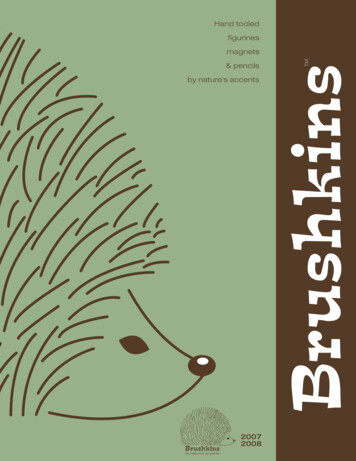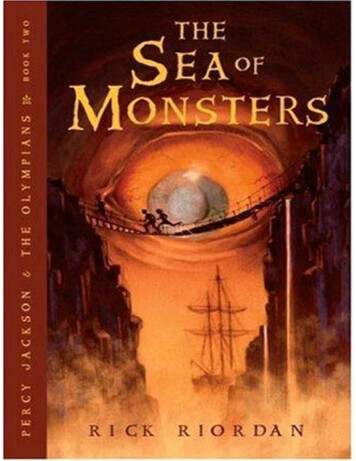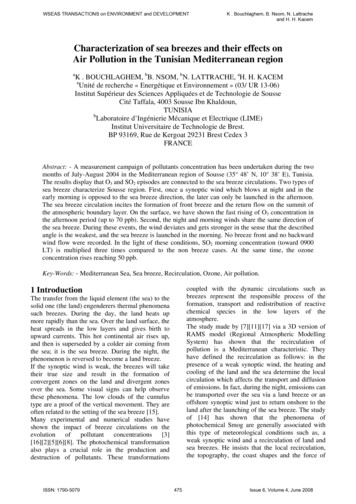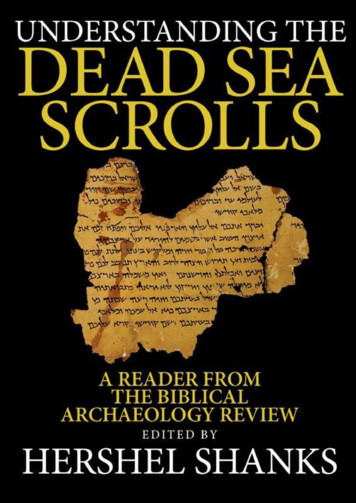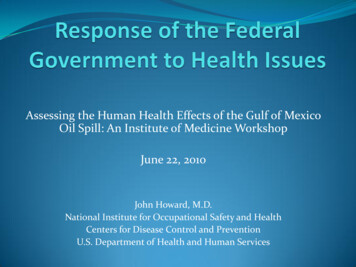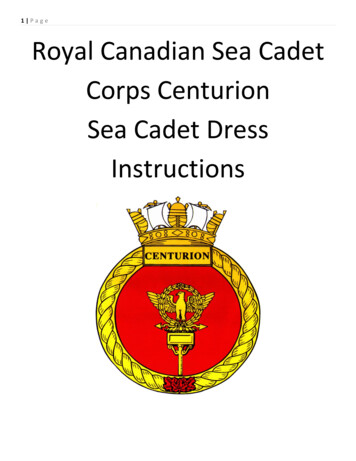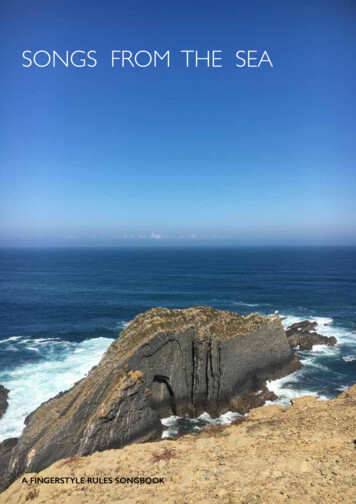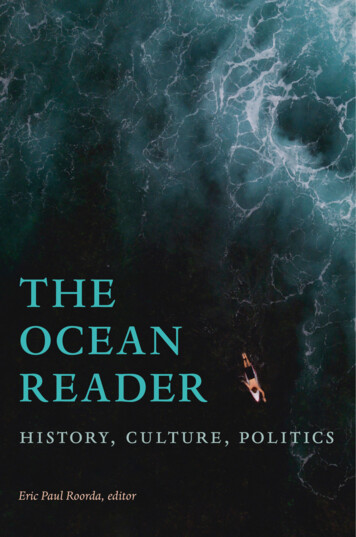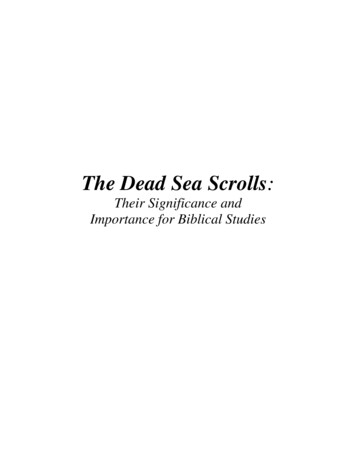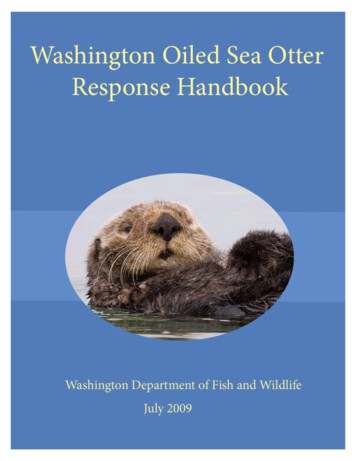
Transcription
Washingon Oiled Sea Otter Response Handbooki
--This page intentionally left blank--Washington Oiled Sea Otter Response Handbookii
Table of ContentsOiled Sea Otter Response OverviewIntroduction and BackgroundConcept of OperationNatural Resource Trustees for Sea Otters and Interested GovernmentsOrganizational Structure and Unit DescriptionsThe Marine Mammal Recovery and Transportation UnitSea Otter Capture TeamCarcass Recovery TeamTransport TeamMorgueThe Marine Mammal Rehabilitation UnitSea Otter Pre-Release FacilityConstruction TeamMarine Mammal Hazing UnitTrainingPersonnel SafetyPress RelationsResponse Levels11233344445555666Sea Otter Collection and Care GuidanceOverview and Genesis of GuidanceReports and DocumentationReconnaissanceAerial ReconnaissanceLand Based ReconnaissanceBoat ReconnaissanceCaptureLand Based CaptureOn Water CaptureDiver CaptureTransportationField StabilizationPrimary Treatment FacilityIntakeWashDryingPost-wash Monitoring and CareNutritional GuidelinesPre-Release FacilityReleaseCarcass ManagementCarcass Recovery TeamWashington Oiled Sea Otter Response iii
Appendices:Appendix 1 – Potential Personnel Resources for Sea Otter ResponseAppendix 2 – USFWS Capture Factors to ConsiderAppendix 3 – Intake ProceduresAppendix 4 – Wash/Rinse ProceduresAppendix 5 – Formula and Hand Rearing GuidelinesAppendix 6 – Weight and Length RangeAppendix 7 – Oiled Marine Mammal FormsAppendix 8 – Oiled Marine Mammal Evidence Collection ProtocolAppendix 9 – Marine Mammal Necropsy ReportAppendix 10 – Treatment Information and OrdersAppendix 11 – Marine Mammal Blood ResultsWashington Oiled Sea Otter Response Handbook2327293537394153556365iv
Oiled Sea Otter Response OverviewIntroduction and BackgroundThe Northwest Wildlife Response Plan (Chapter 9970, II, A, iii) directs the USFWS and WDFWto develop appropriate response actions to effectively recover and care for oiled sea otters in theNorthwest Area. It further directs the trustees to authorize individuals to collect, transport andrehabilitate oiled sea otters within the legal framework of the Marine Mammal Protection Act (16USC 1379(h) and 1382(c)). This Handbook provides the organizational and specific operationalguidance needed to conduct an oiled sea otter recovery and rehabilitation effort. It describes howoiled sea otters would be located and recovered on the outer coast of Washington State, how theywould be transported to treatment facilities for rehabilitation and then re-acclimated for releaseback into the wild. This handbook is intended to provide guidance when dealing with oiledotters. The Wildlife Branch Director may make adjustments to this guidance based onsituational circumstances and expert opinion.In recent years, approximately 1,100 sea otters (Enhydra lutris kenyoni) were estimated topopulate the outer coast of Washington. This growing population of sea otters is found along thecoast from Point Grenville north to Neah Bay and is at risk from an oil spill affecting thosewaters. Unlike most marine mammals that possess a thick layer of insulating blubber sea ottersare highly vulnerable to oil because they depend on their exquisitely maintained pelage (fur) forinsulation. When sea otter fur becomes oiled there is an immediate loss of thermal protection.Sea otters in Washington State are not listed under the Federal Endangered Species Act, but theyare listed as Endangered on Washington’s Species of Concern (SOC) List and they are protectedby the Marine Mammal Protection Act.I.Concept of OperationEfforts to rescue sea otters injured during an oil spill must be performed as an integrated part ofthe overall oil spill response effort in accordance with the Northwest Area Contingency Plan(NWACP) and the Northwest Wildlife Response Plan, Section 9970. The Responsible Party (RP)is expected to initiate and fund sea otter rescue operations in accordance with the plan. In theevent that there is not an identified RP the Wildlife Branch will request that the UnifiedCommand authorize expenditures from the Oil Spill Liability Trust Fund (OSLTF) to implementthe oiled sea otter response.Oiled otters will be located and recovered by reconnaissance and capture teams working out ofstaging areas on the Olympic Coast. A separate transport team will transport captured animals asquickly as possible, preferably by air, to a primary treatment facility. Once there, the animalswill be admitted, evaluated, stabilized, washed and then supported thru primary recovery. Theanimals will be cared for until they have their pelage reconditioned and vital health parametersrestored. Once the animals are waterproof and in good condition and have passed a healthscreening approved by USFWS they will be transferred to a pre-release facility until USFWSdetermines when where and how they can be released.Washington Oiled Sea Otter Response Handbook1
Currently there is not a dedicated primary treatment facility for oiled otter rehabilitation in theNorthwest. Consequently, this sea otter response plan relies on a combination of mobile facilities(specially equipped trailers and tents) and the voluntary assistance of participating publicaquariums to care for and house otters.II. Natural Resource Trustees for Sea Otters and InterestedGovernmentsThe USFWS is the lead federal trustee agency with responsibility for protection and managementof sea otters, and WDFW is the state trustee with similar responsibilities. Initial notifications willbe made to the natural resource trustee agencies by the OSC’s in accordance with the NorthwestArea Contingency Plan (Chapters 3000 and 9000). The Wildlife Brach Director can contact thefollowing interested groups with follow up information and requests for assistance using thecontact numbers below.Agency and Tribal Contact InformationUS Fish and Wildlife Service(360) 971-6000Wash. Dept. of Fish and Wildlife(360) 534-8233Makah Tribe(360) 645-2201Quileute Tribe(360) 374-6163Hoh Tribe(360) 374-6582Quinault Nation(360) 276-8211Olympic National Park(360) 565-3000Olympic Coast NMS(360) 457-6622, x13Wash. Maritime NWR Complex(360) 457-8451These groups may be notified by the Wildlife Branch but are not formal trustees:Point Defiance Zoo and Aquarium(253)677-3386(206) 463-3149(253) 677-1543Seattle Aquarium(206) 604-0790Vancouver BC Aquarium(415) 847-2781Marine Mammal Rescue Center Pager(604) 735-4777Oregon Coast Aquarium(541) 867-3474 x5577National Marine Fisheries Marine Mammal Stranding Network(206) 526-6733Washington Oiled Sea Otter Response Handbook2
III. Organizational Structure and Unit DescriptionsThe Northwest Area Contingency Plan (NWACP) and the Wildlife Rescue Plan (Chapter 9970)describe the general organizational structure for wildlife response. This Handbook specifies thefollowing additional functional units (shaded) specific to sea otter rescue. Duties and issues thatrelate to a specific position or team are listed in the sections that follow.The Marine Mammal Recovery and Transportation UnitThe Marine Mammal Recovery and Transport Unit leader is responsible for recovering live anddead oiled sea otters and their transportation to appropriate facilities. The leader willcoordinating the response to reports of oiled sea otters coming from the Reconnaissance Unit,other spill response field teams and members of the public. Depending upon the size andcomplexity of the response the following teams and positions may be established. The teams willbe managed by the Marine Mammal Recovery and Transport Unit leader who will consolidatethe personnel and equipment needs and forward them to logistics via the Wildlife BranchDirector. Dead otters will be collected by the Capture Team. However, if carcasses are sonumerous that it impairs the ability of the Capture Team to recover living animals then theMarine Mammal Recovery and Transport Unit leader will deploy separate Carcass RecoveryTeams.Sea Otter Capture TeamThe Sea Otter Capture Team is responsible for recovery of oiled sea otters (live anddead). The Capture Team leader is responsible for forming capture teams of appropriatepersonnel equipped to locate and capture oil injured sea otters. The Team Leader isresponsible for directing, tracking and reporting results from all deployed capture teams.The leader will ensure that all team members receive a safety and assignment brief priorto daily operations and will request needed equipment and provisions through the MarineMammal Recovery and Transportation Unit. The Capture Team leader will communicatewith the Transport Team leader concerning estimated arrival times and locations forcaptured animals needing transport.Washington Oiled Sea Otter Response Handbook3
Carcass Recovery TeamThe Carcass Recovery Team Leader is responsible for collecting dead sea otter carcasses.The Team Leader is responsible for forming carcass recovery teams of appropriatepersonnel and equipment to relocate and recover dead sea otters. Recovery operationswill be fully documented with the location and condition of the recovered animal.Carcasses will be transferred via the Transport Team to the designated morgue. Chainof-custody documentation will be maintained throughout the process.Transport TeamThe transport team is responsible for transporting live animals from the field to thetreatment facility as well as carcasses to the morgue. The Transport Team leader isresponsible for coordinating the capture and transportation teams and will notify theprimary treatment facility as to when animals will be arriving. The Team Leader willensure that all team members receive a safety and assignment brief prior to dailyoperations. The leader will request needed equipment and provisions through the MarineMammal Recovery and Transportation Unit.MorgueThe Morgue Supervisor is responsible for receiving, documenting and storing spillrelated animal mortalities. The Morgue Supervisor will provide daily reports regardingthe number of carcasses in custody at the morgue to the Marine Mammal Recovery andTransportation Unit Leader. The Supervisor will request needed equipment andprovisions through the Marine Mammal Recovery and Transportation Unit leader.The Marine Mammal Rehabilitation UnitThe Marine Mammal Rehabilitation Unit is responsible for the operation of the PrimaryTreatment Facility, Sea Otter Conditioning Sites and Pre-release Facility. The mission of the unitis to restore oiled sea otters to a healthy condition and prepare the animals for release into theirnatural habitat. The Unit will determine staff and equipment needs and submit appropriaterequisition requests through the Wildlife Branch Director.The Marine Mammal Rehabilitation Manager is responsible for setting up and operating thetreatment and pre-release facilities, establishing safe and appropriate housing for the animals andfacilitating animal husbandry activities. The manager coordinates the flow of animals fromintake thru release. The manager will receive instructions either verbally during the early hoursof the response and/or via an ICS-204 assignment form. The manager will ensure that all staffmembers receive a safety and assignment brief prior to daily operations.Five Teams report directly to the Marine Mammal Rehabilitation Manager: Intake Team Wash Team Animal Husbandry Team Animal Food Prep Team Maintenance TeamWashington Oiled Sea Otter Response Handbook4
The Intake Team conducts the initial examination, evaluation, documentation and tagging of theanimal and provides treatment to stabilize the animal. The Wash Team anesthetizes, washes,rinses and dries the animal. The Animal Husbandry Team monitors and cares for the animals ateither the Primary Treatment Facility, alternate sea otter conditioning sites or at the pre-releasefacility. The Animal Food Prep Team prepares and delivers food for the animals at either thePrimary Treatment Facility, alternate sea otter conditioning sites or at the pre-release facility.The Maintenance Team is responsible for maintaining and repairing the Primary TreatmentFacility, the Pre-release Facility and any associated equipment.Sea Otter Pre-Release FacilityThe mission of the Pre-Release Facility is to facilitate animal husbandry activities and providesafe and appropriate housing for the animals while they regain strength prior to release. The Prerelease Facility Manager reports to the Marine Mammal Rehabilitation Unit, and is responsiblefor construction and operation of the pre-release facility. The manager will receive hisinstructions either verbally during the early hours of the response and/or via an ICS-204assignment form. The manger will ensure that all staff members receive a safety and assignmentbrief prior to daily operations. The manager will manage the construction and maintenance of thePre-Release Facility. Depending on the logistics of the operation food may be prepared at thePrimary-Treatment Facility and then transported to the Pre-release facility daily. The managerwill request needed equipment and provisions through the Marine Mammal Rehabilitation Unit.Construction TeamThe Construction Team orders and assembles components of the pre-release facilityincluding the floating net pens and necessary support structures such as a shed to housefood prep and animal monitoring.Marine Mammal Hazing UnitSea otters are generally considered difficult to haze because they dive and scatter whendisturbed, but often return to the original location. Although, sensitive to noise and otherdisturbances no proven technique for herding otters out of an area is known. Activation of theMarine Mammal Hazing Unit for a sea otter response will be considered by the Wildlife BranchDirector on a case by case basis.IV. TrainingWhen possible, personnel with experience working with sea otters should be used for tasks thatinvolve contact with the animal. People with this experience include: sea otter researches,appropriate aquaria staff and Federal, State or tribal resource managers. The number of peoplerequired to execute an oiled otter rescue and rehabilitation operation is large and it will severelytax the available pool of workers with experience with sea otters. Consequently, experiencedworkers will need to be placed strategically and used to supervise inexperienced personnel. Forthe larger responses it may be necessary to institute a formal introductory training program toprepare inexperienced personnel to deal with sea otters.Washington Oiled Sea Otter Response Handbook5
V. Personnel SafetyAll personnel working on tasks where exposure to oil is likely must be current in OccupationalSafety and Health Administration (OSHA) training and job specific safety training in accordancewith the Northwest Wildlife Response Plan. Additionally, all workers must be provided a dailysafety brief prior to beginning operations and they are required to conform to the Site Safety Planand the incident specific Wildlife Branch Safety Plan for the response.VI.Press RelationsAll information that is to be released to the public must be done so via the Public InformationOfficer (PIO) and the Joint Information Center (JIC). There is a very high level of public interestin oil injured wildlife and sea otters in particular. The PIO in coordination with the WBD willfacilitate appropriate interviews or photo opportunities for the press. Press teams arriving withoutprior approval should be directed to the PIO. If field teams encounter press teams they shouldadvise them not to interfere in the field operations and they should not give interviews withoutthe approval of the PIO. Crews members may identify themselves by name and explain thegeneral nature of their work (i.e., we are capturing oiled sea otters or recovering dead sea otters)but should make no statements concerning impact or cause of the spill or answers any questionthat calls for speculation.VII. Response LevelsThe size of the spill and more importantly the number of sea otters affected will determine thenumbers of staff that are needed to perform the functions identified above. The numbers ofpersonnel needed for various levels of sea otter impacts are listed by function in Table 1. Thelevels are as follows:Level ILevel IILevel IIILevel IVmore than 100 sea otters (Daily intake not to exceed 40 otters)50 to 99 sea otters (Daily intake not to exceed 24 otters)10 to 49 sea otters (Daily intake not to exceed 12 otters)1 to 9 sea otters (Daily intake not to exceed 6 otters)Table 1 and 1a identify the estimated personnel and equipment that would be required to mount aresponse appropriate to the levels listed above. It is probable that an oil spill on the outer coastwould impact both sea otters and marine birds. Consequently some positions may serve dualfunction for both birds and otters. These positions include the Wildlife Branch Director, WildlifeVeterinarian, the Wildlife Reconnaissance Group and associated equipment.Washington Oiled Sea Otter Response Handbook6
Table 1 Personnel Needs for Sea Otter Collection and Rehabilitation by Response LevelResponse LevelPersonnelWildlife Branch DirectorDeputy Wildlife Branch DirectorWildlife VeterinarianMarine Mammal Recovery & Rehabilitation Group SupervisorDeputy Marine Mammal Recovery & Rehabilitation Group SupervisorMarine Mammal Recovery and Transportation Unit LeaderDeputy Marine Mammal Recovery and Transportation Unit LeaderSea Otter Capture Team LeaderSea Otter Capture Team StaffSea Otter Transport Team LeaderSea Otter Transport Team StaffMort Recovery Team LeaderMort Recovery Team StaffMorgue SupervisorMarine Mammal Hazing Unit LeaderDeputy Marine Mammal Hazing Unit LeaderMarine Mammal Hazing Unit StaffMarine Mammal Rehabilitation Unit LeaderDeputy Marine Mammal Rehabilitation Unit LeaderSea Otter Primary Care Facility ManagerMaintenance TeamIntake Team (DVM 2 animal handlers recorder)Wash Team (Anesthesia 3 to 5)Animal Husbandry Team (DVM 2handlers 1 additional for every 6 more otters)Animal Food Prep Team (15 lb of food per otter per day) L4 15-135 lb, L3 150-735 lb, L2 750-1485 lb, L1 1500 lbSea Otter Conditioning Site LeaderAnimal Husbandry TeamAnimal Food Prep TeamMaintenance TeamSea Otter Pre-release Facility ManagerConstruction TeamAnimal Husbandry Team (As needed similar numbers to those assigned to primary treatment facility)Maintenance Team (Retained from construction team as needed)Animal Food Prep TeamVolunteer Coordinator **Wildlife Reconnaissance Group Supervisor **Aerial Survey Unit Leader **Aerial Survey Unit Staff **Boat Survey Unit Leader **Boat Survey Unit Staff **Shoreline Survey Unit Leader **Shoreline Survey Unit Staff *** Hazing to be considered on a case by case basis for otters (staffing dependent on method selected).** May not need to duplicate staff likely in place for bird reconnaissance.Washington Oiled Sea Otter Response HandbookLevel IV Level III Level II1 or 9 10 to 49 50 to 99Level I 1001010-1011121011412 to 32 to 48 to1613 to 6141***112411311114 to 816 to 3226 to 10141***11288 to 124 to 124 to 614 to 124 to 64184 to 1284 to 611 to 20-11 to 20-12 0-1612 to 16 16 t0 2412 to 2020 6 to 8 8 to 101 to 22 to 312 to 2020 6 to 8 8 to 1081211121212 to 2020 12126 to 8 8 to 101 to 22 to 32 to 32 to 3112 to 45 115 10 118151***0-112 to 344 to 642 to 4042 to 42 to 314442 to 40-10 -10-110-10-20-13711 to 2411111040210142***12212
Table 1a Equipment Needs for Sea Otter Collection and Rehabilitation by Response LevelResponse LevelEQUIPMENTCapture and Transport EquipmentDip NetBite pillowHerding boardsrestraint boxVehicle - Recovery (pick-up or cargo van)Vehicle - TransportCoolers of iceBoat - CaptureATVs (if approved for use)Helicopter on call for land/water recoveryFixed wing aircraft on call for otter transportSky kennels for capture and transportField Stabilization Facility (optional)Treatment EquipmentHolding cages (for drying critical care monitoring) 4 per wash stationTemp controlled holding area (approximate)Wash Rince Dry Station - Permanent or temporary (i.e. 53 foot response trailer)Post Wash Holding (2 otter pens) or suitable segregated available space in non-display tanksFreshwater maximum daily consumption (wash and holding in 2-otter cages)Post waterproofing holding pools (Circular 14 ft diameter 4 foot deep) hold 6 compatible animalsSaltwater daily maximum consumption (gallons)Towels for drying otters (per day)Pet Dryers (one per cage)Food preparation capacity per day in poundsVehicle to pick up food suppliesSea Otter Conditioning sitesPre-Release Facility EquipmentPre release Pen (10x18 net pen plus floats) 8 otters each with pad for special grouping i.e. mother with pupsStaff Support facility (Building or boat to shelter and support sea otter monitoring and care staff)Food preparation facility (Not needed if food prepared at Primary Care Facility and shipped daily)BoatsTransport Cages (Probably the same ones used for collection)Washington Oiled Sea Otter Response HandbookLevel IV Level III Level II1 or 9 10 to 49 50 to 99Level I 100123122 to 31110-10-160-12 to 44 to 86 to 122 to 44 to 82 to 32 to 42 to 42 to 40-10-1120-14 to 88 to 166 to 94 to 88 to 162 to 34 to 84 to 84 to 81 to21 to224110 20 10 10 20 3 10 10 10 1 to 21 to 224 1410x1011 to 53960024416006041351 car18 to 1610x1001 to 25 to16122400919872001208 to 16150 to 7351 pick-up1 to 220 to 3250x1003 to 417 to 272088009 to 15331200024020 to 32750 to14851 pick-up2 to 440 50x100 5 to 727 plus22560016 375360025040 1500 1 van41 to 2111 to 266 to 8111 to 21212 to 14111 to 22414 111 to 224 8
Sea Otter Collection and Care GuidanceOverview and Genesis of GuidanceIn the event of an oil spill that is likely to impact Washington’s coastal population of sea ottersThe Northwest Area Contingency Plan and the Wildlife Response Plan will be activated. ThisHandbook summarizes and documents oiled sea otter capture and rehabilitation protocols thatshould be used in Washington State. As stated earlier, the Wildlife Branch Director may makeadjustments to this guidance based on situational circumstances and expert opinion.Various sources were used to develop the document. Following the March 24, 1989 ExxonValdez oil spill, efforts were made to rehabilitate as many of the 357 recovered oil-impacted seaotters as possible. This effort resulted in a significant accumulation of experience much of whichwas published by Williams and Davis in their seminal 1995 publication “Emergency Care andRehabilitation of Oiled Sea Otters. More recently efforts by the BC/States Oil Spill Task Force,the California Office of Spill Prevention and Response (OSPR) and NOAA have identifiedprotocols for the collection, treatment and eventual release of oil-injured sea otters. Lessonslearned from these efforts have been incorporated into this document. In particular a large part ofthe protocols that were originally produced for OSPR by the Oiled Wildlife Care Network(OWCN) have been adopted, modified, and included in this document.Special thanks to those who helped prepare and review this section: Mike Ziccardi (OiledWildlife Care Network, Dave Jessup,(California Office of Spill Prevention and Response), JohnRupp, Karen Goodrowe and Lisa Triggs, (Point Defiance Zoo and Aquarium), Martin Hulena(Vancouver BC Aquarium), Jim Burke, and Judy Tuttle (Oregon Coast Aquarium), C.J. Casson,Traci Belting and Shawn Larson (Seattle Aquarium), Deanna Lynch and Cindy Schexnider(United States Fish and Wildlife Service) , Ed Bolby (Olympic Coast Marine Sanctuary) SteveJeffries, Barry Troutman, Andy Carlson and Don Noviello (Washington State Department ofFish and Wildlife).Reports and DocumentationThe following records will be prepared as described in the appropriate sections to follow.Copies can be found in the indicated appendices of this document. Records will ultimately beretained by the USFWS. When possible team leaders and unit managers should retain a copy ofall filled out forms. Search effort logs and position reports originals are to be forwarded via theDocumentation Unit to the Wildlife Brach Director. The live and dead animal data logs shouldbe kept with the animals until treatment is complete. Copies are to be forwarded via theWashington Oiled Sea Otter Response Handbook9
Documentation Unit to the Wildlife Brach Director whenever the animal is transferred betweenlocations or units.1.2.3.4.5.6.7.8.9.Oiled Marine Mammal Search Effort LogOiled Marine Mammal Position ReportOiled Marine Mammal Data Log: Live AnimalsOiled Marine Mammal Data Log: Dead AnimalsOiled Marine Mammal Intake FormOiled Marine Mammal Daily Progress FormMarine Mammal Necropsy ReportTreatment Information and Orders FormMarine Mammal Blood ResultAppendix 7Appendix 7Appendix 7Appendix 7Appendix 7Appendix 7Appendix 9Appendix 10Appendix 11ReconnaissanceIn the event of a spill, or potential spill, near areas inhabited by sea otters the Wildlife Branchconducts aerial, land, and water reconnaissance to determine the threat to sea otters. It is criticalthat at least one person on every reconnaissance team be familiar with locating and observing seaotters. Personnel from USFWS, WDFW, Olympic Coast National Marine Sanctuary (OCNMS)and other otter research groups should be contacted. Consult Appendix 1, Tables 1 and 2 for alist of potential aerial and shore side reconnaissance personnel. Information gathered will be usedto respond in a manner appropriate to the situation. Details of all search efforts (aerial, land orboat based) and location of live and dead animals encountered must be recorded on an OiledMarine Mammal Search Effort Log and Oiled Marine Mammal Position Report (Appendix 7).This information must be communicated back to the Situation Unit, Environmental Unit andWildlife Branch via the Wildlife Reconnaissance Group leader by the quickest means possible(radio, satellite phone, cell phone, landline).Aerial reconnaissance flights specifically designed to locate and assess concentrations of ottersin the oil spill trajectory area will be requested from the Marine Mammal Reconnaissance Group.These flights are best conducted using fixed wing aircraft and trained sea otter observers tooverfly known sea otter concentration areas to further investigate oil impacts on otters in theseareas. Much of the staff for Wildlife Reconnaissance Group may also serve for reconnaissance ofbirds and other wildlife but at least one observer trained in aerial reconnaissance of sea ottersmust be included on these flights. Flights should operate at an altitude high enough to minimizedisturbance of sea otters (usually at least 800 feet and greater altitudes will be necessary fornoisier aircraft). Requests for air assets must be coordinated through the Air Ops unit inPlanning as per the Incident Command Structure defined in the NWACP. Results of allreconnaissance flights including the area covered, viewing conditions, the position of observedsea otters and the proximity of these animals to oil must be communicated back to the SituationUnit, Environmental Unit and Wildlife Branch via the Wildlife Reconnaissance Group leader bythe quickest means possible (radio, satellite phone, cell phone, landline). Teams should beprovided with GPS capability (either handheld with external antenna or aircraft-mounted),marine VHF radio, maps or chart copies of sufficient detail to mark precise locations of ottersightings, binoculars, digital camera with lens focal length between 100mm and 200mm, and alogbook for recording sightings of sea otters or other marine mammals, and appropriate flightWashington Oiled Sea Otter Response Handbook10
safety equipment as determined by the Safety Officer in consultation with the Air OperationsUnit.Land based reconnaissance teams will consist of at least two people equipped with: binoculars,spotting scope, digital camera, GPS, VHF radio, topographic maps, satellite phone and/or cellphone, documentation forms and supplies, Rite-in-the-Rain field notebook, Oiled MarineMammal Search Effort Log s and Oiled Marine Mammal Position Reports (Appendix 7),surveyor’s flagging tape, suitable body (evidence) tags, flashlight, water, first aid kit, daypack,personal protective equipment, ATV (only for appropriate approved sites), and emergencysurvival gear. Teams will be given specific assignments to search specific locations. Sites wheresea otters are located can be flagged with colored tape to assist the capture team in locating siteswhere otters have been observed. The date, color, and position of the flagging should be notedand the flagging itself should be labeled with the date of the observation to separate oldobservations from later ones. Dead animals should also be photographed, tagged, and thencollected or secured above the high tide line if possible. Personnel that encounter oil during theirreconnaissance efforts must complete appropriate decontamination prior to returning to non-oiledlocations.Boat reconnaissance teams may be utilized. These teams may be able to reach remote areasfaster and investigate offshore rocks and islands more completely. Boat operators must haveexperience in operating small craft along Washington’s outer coast, especially in near shore areasaround rocks, islands and kelp beds. These teams will consist of at least two people equippedwith: binoculars, spotting scope, digital camera, GPS, marine VHF radio, nautical charts, satellitephone and/or cell phone, documentation forms and supplies, Rite-in-the-Rain field notebook,Oiled Marine Mammal Search Effort Logs and Oiled Marine Mammal Position Reports(Appendix 7), surveyor’s flagging tape, suitable body (evidence) tags, flash light, water, first aidkit, daypack, personal protective equipment, and emergency survival gear. Teams will be givenspecific assignments to search specific sections of the coastline from the water. Dead animalsfound in the water must be collected and shall be photographed, tagged, and the recoverylocation (latitude and longitude) recorded. Shallow draft, maneuve
The USFWS is the lead federal trustee agency with responsibility for protection and management of sea otters, and WDFW is the state trustee with similar responsibilities. Initial notifications will be made to the natural resource trustee agencies by the OSC's in accordance with the Northwest Area Contingency Plan (Chapters 3000 and 9000).
